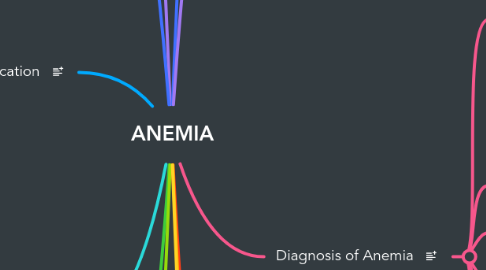
1. Treatment Options
1.1. Medications
1.1.1. ESA - erytopietein stimulating agent
1.1.1.1. EPO at the kidney • Ensure bp in control bcs ESA maybe increase the bp
1.1.2. erythropoietin
1.1.3. vit B12 for pernicious anemia
1.1.4. iron, folic acid (given ferrous fumarate
1.1.4.1. oral form and highest iron)
1.2. Nutritional counselling
1.2.1. hematinic - iron, folic acid, b12, it c (absorption of iron) in the hospital given - b complex bes b12 is expensive (diabetes)
1.2.1.1. why patient do not like to take iron:constipation & irony taste buang air besar (like normal) - 2hrs before eat - can take at night & morning
1.3. Blood transfusion
1.4. Bone marrow transplant
2. Complications and Risks
2.1. Developmental delays in children
2.2. Pregnancy complications
2.2.1. -Share with the baby so lower hb level
2.2.1.1. if not baby akan premature, low oxygen, not enough to replenish so can cause death
2.3. Increased risk of infections
2.4. Heart problems
2.5. Chronic disease
2.6. Intestinal disorder
2.7. Poor diet
2.8. Menstruating
2.9. people engage with vigorous athletic
2.9.1. breaking down of RBs in blood stream
3. Counselling and Patient Education
3.1. Importance of medication adherence
3.2. Dietary recommendations
3.2.1. less coffee
3.2.2. -food high in iron - daging merah, kerang, hatiayam, salmon - dates. kacang kuda (Chickpea). salmon
3.3. Lifestyle modifications
3.4. Follow-up tests and monitoring
4. Pharmacist's Role in Anemia Management
4.1. Identifying and managing drug-induced anemia
4.1.1. when patient have low Hb have end stage renal disease so hbac will not be reflecting the actual reading
4.2. Collabrating with healthcare teams
4.3. Patient counseling on medications side effects
4.4. Theraphy optimization and medication management
5. Treatments
5.1. Depends on cause
5.1.1. - iron deficiency anemia: taking iron supplements & changes if diet - vit deficiency anemia: folic acid and B12 deficiency (dietary supplements) - anemia of chronic disease: no specific treatment so focus treat underlying disease. If severe, blood transfusions/ injection of erythropoietin - aplastic anemia: blood transfusions & bone maroow transplants anemia associated with bone marrow disease: chemotherapy/ bone marrow transplantation - hemolytic anemia: avoid suspect medications. take drugs suppress immune system. blood transfusions. plasmapheresis. removal of spleen - sickle cell anemia: folic acid supplements. antibiotic, blood transfusions - thalassemia: blood transfusions. folic acid supplements. removal of spleen / blood/ bone marrow
5.2. - oral - iviron - epocitin alpha & beta for cKD not on dialysis & on dialysis * epocitin alpha * epocitin alpha dose adjustment * epocitin alpha monitoring * epocitin beta (mircera & recormon)
6. Morphologic Rbc size
6.1. Hypochromic
6.2. Microcytic, hyperchromic
6.2.1. genetic abnormalities (sickle cell & thalassemia)
6.2.2. Iron deficiency
6.3. Normochromic, normocytic
6.3.1. recent blood loss, hemolysis chronic disease, renal failure,autoimmune, endocrine
6.4. Macrocytic
6.4.1. defective maturation w decreased production
6.4.2. megaloblastic
6.4.2.1. pernicious (Vit B12 deficiency). folic acid deficiency
7. Types of Anemia
7.1. Iron deficiency anemia
7.1.1. < iron due to blood loss/ poor oral absorption
7.1.1.1. At risk: preggy/childbirth / gastric bypass surgery for weight loss (poor absorption)
7.2. Vitamin deficiency anemia
7.2.1. < vit B12/ folic acid due to poor dietary
7.2.1.1. Pernicious anemia (Vit B12 cannot be absorbed in git
7.3. Hemolytic anemia
7.3.1. Rbc broken in bloodstream/spleen due to leaky heart valves/ aneurysm, infection, autoimmune disorder, congenital abnormalities in RBC
7.3.1.1. Inherited abnormalities effect Hb/ Rbc structure & fx
7.3.1.1.1. Thalessemia, low levels of enzymes (G6pd deficiency
7.4. Sickle cell anemia
7.4.1. Inherited hemolytic anemia, Hb protein abnormal
7.4.1.1. Rbc rigid and clog the blood circulation, unable to flow via small blood vessels
7.5. Aplastic anemia
7.5.1. Body stop making enuf Rbc
7.5.1.1. viral infection, exposure to toxic chemicals. drugs
7.5.1.1.1. idiopathic aplastic anemia (low RBCS production unknown
8. Symptoms of Anemia
8.1. Fatigue
8.2. Weakness
8.3. Shortness of breath
8.4. Dizziness
8.5. Pale skin
8.6. severe anemia - fainting - chest pain - angina - heart attack
8.7. fast or irregular heartbeat headache- chest pain
9. Diagnosis of Anemia
9.1. Complete blood count
9.1.1. RBC. WBC & platelet count
9.1.2. wBc differential
9.1.3. Hematocrit
9.1.4. Hb
9.1.5. MCV MCH MCHC
9.1.6. RBC distribution width
9.2. Blood smear
9.3. Serum ferritin level
9.4. Iron studies
9.4.1. involve dietary
9.5. total iron-binding capacity (TIBC)
9.6. unsaturated iron-binding capacity (UIBC)
9.7. G6PD test
9.8. coombs test
9.9. reticulocyte count
9.10. serum iron
9.11. Transferrin saturation
10. Definition
10.1. Occurs when do not have enough RBC/ RBC not fx properly
10.2. Normal Hb value
10.2.1. <12 gm/dl women
10.2.2. < 13.5/14 gm/dl men
10.2.3. < 13.5/14 gm/dl men
